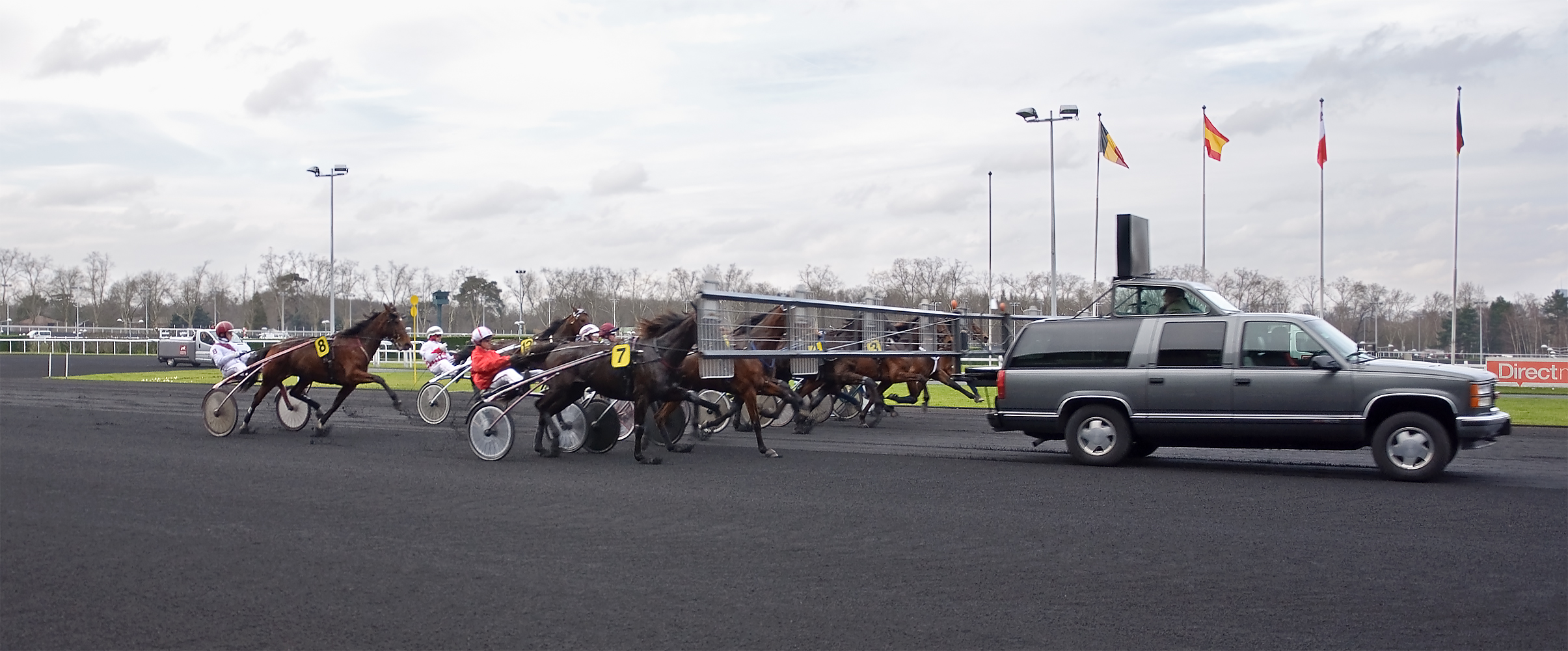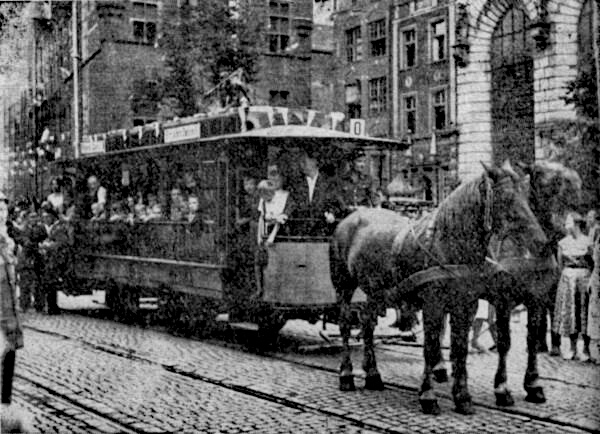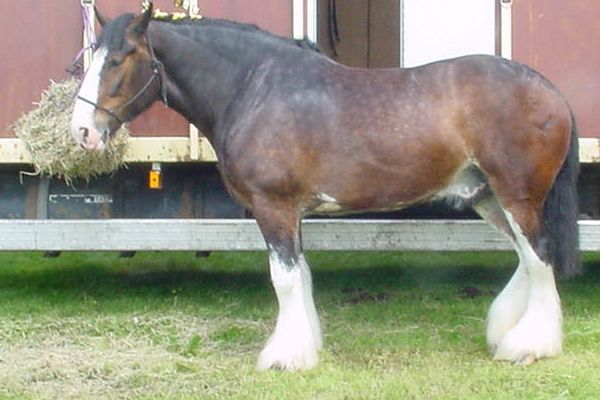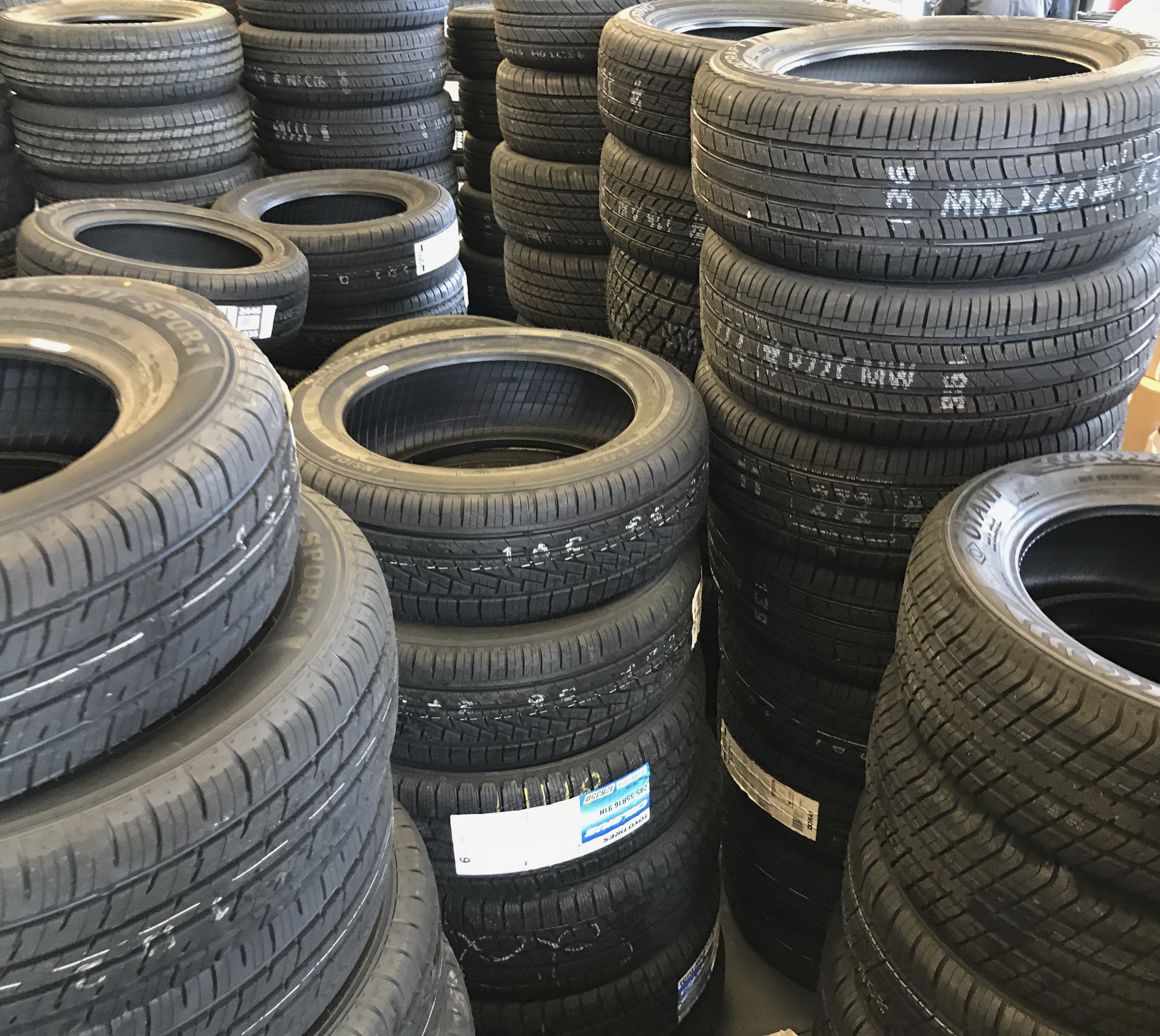|
Sulky
A sulky is a lightweight cart used for harness racing. It has two wheels and a small seat for only a single driver. The modern racing sulky has shafts that extend in a continuous bow behind the driver's seat, with wire-spoked "bike" wheels and inflated tyres. A sulky is frequently called a "bike". Historically, sulkies were built for trotting matches and made from wood with very tall wheels and almost no body, just a simple frame supporting a single seat. Such vehicles were called "sulkies" because they were "said to have been chosen by unsociable people fond of their own company or fits of sulking". A horse show vehicle used in roadster classes is also called a sulky. The drivers dress in racing silks and show their horses at a fast trot around the showring. Other uses of the term ''sulky'' include: * the single metal seat found on many horse-drawn agricultural implements such as ploughs, mowers and rakes. * the logging arch, a log-transport tool on wheels, is also cal ... [...More Info...] [...Related Items...] OR: [Wikipedia] [Google] [Baidu] |
Harness Racing
Harness racing is a form of horse racing in which the horses race at a specific gait (a trot or a pace). They usually pull a two-wheeled cart called a sulky, spider, or chariot occupied by a driver. In Europe, and less frequently in Australia and New Zealand, races with jockeys riding directly on saddled trotters ( in French) are also conducted. Breeds In North America, harness races are restricted to Standardbred horses, although European racehorses may also be French Trotters or Russian Trotters, or have mixed ancestry with lineages from multiple breeds. Orlov Trotters race separately in Russia. The light cold-blooded Coldblood trotters and Finnhorses race separately in Finland, Norway and Sweden. Standardbreds are so named because in the early years of the Standardbred stud book, only horses who could trot or pace a mile in a ''standard'' time (or whose progeny could do so) of no more than 2 minutes, 30 seconds were admitted to the book. The horses have proportiona ... [...More Info...] [...Related Items...] OR: [Wikipedia] [Google] [Baidu] |
Drafting (dog)
Drafting (also known as carting) is an activity or List of dog sports, dog sport in which a dog (usually a large Dog breed, breed) pulls a cart or wagon filled with supplies, such as farm goods, camping equipment, groceries or firewood, but sometimes pulling people. History Drafting involves dogs pulling a cart or wagon, a task historically performed to assist farmers with transporting goods. Ancient History The use of the travois for drafting was practiced in North America, particularly among the Plains Indians. Significant historic routes, such as the Lewis and Clark Trail-Travois Road and Montana's Lewis and Clark Pass, were heavily traversed by travelers using travois. The repeated passage created deep, parallel grooves in the terrain—marks that remain visible today. Additional remnants of travois tracks can be found at the Knife River Indian Villages National Historic Site. Archaeological evidence indicates that travois were utilized prior to the invention of the whee ... [...More Info...] [...Related Items...] OR: [Wikipedia] [Google] [Baidu] |
Roadster (horse)
Roadster is a type of driving competition for horses and ponies where the horse and exhibitor appear in equipment similar to that used in harness racing. It is derived from the historical use of certain horses hitched to light carts that traveled quickly from one place to another, often racing on ordinary dirt roads, hence the name. The term is also used to describe the horse used for such competition. Horses pull a light sulky and drivers wear racing silks. However, the exhibitors do not race. Instead, they perform in an arena at horse show A horse show is a judged exhibition of horses and pony, ponies. Many different horse breeds and equestrianism, equestrian disciplines hold competitions worldwide, from local to the international levels. Most horse shows run from one to three days ...s at trotting gaits that include a slow jog, a medium speed "road gait," and a rapid and long-strided but controlled trot referred to as showing "at speed." Animals are evaluated on performan ... [...More Info...] [...Related Items...] OR: [Wikipedia] [Google] [Baidu] |
Hackney Pony (7714709846)
The Hackney pony is a breed of pony closely related to the Hackney horse. Originally bred to pull carriages, they are used today primarily as show ponies. The breed does not have its own stud book, but shares one with the Hackney horse in all countries that have an official Hackney Stud Book Registry. History The Hackney Pony was originally developed by Christopher Wilson. He used Sir George, a Hackney stallion foaled in 1866, to breed with Fell Pony mares, and then interbred the offspring to make a fixed type of pony. He desired to create not a miniaturized horse, but rather a true pony with such characteristics. Extracting the large trot and other characteristics of the hackney horse and applying them to this true type of pony, he was successful in creating the form which was desired. This is one case of an entire type of breed that is formed in a controlled, private environment. In addition to the mixing of Fell ponies and Hackney horses, the Hackney Pony probably also ... [...More Info...] [...Related Items...] OR: [Wikipedia] [Google] [Baidu] |
Saddle
A saddle is a supportive structure for a rider of an animal, fastened to an animal's back by a girth. The most common type is equestrian. However, specialized saddles have been created for oxen, camels and other animals. It is not known precisely when riders first began to use some sort of padding or protection, but a blanket attached by some form of surcingle or girth was probably the first "saddle", followed later by more elaborate padded designs. The solid saddle tree was a later invention, and though early stirrup designs predated the invention of the solid tree, the paired stirrup, which attached to the tree, was the last element of the saddle to reach the basic form that is still used today. Present-day saddles come in a wide variety of styles, each designed for a specific equestrianism discipline, and require careful fit to both the rider and the horse. Proper saddle care can extend the useful life of a saddle, often for decades. The saddle was a crucial step in ... [...More Info...] [...Related Items...] OR: [Wikipedia] [Google] [Baidu] |
Horse-drawn Vehicle
A horse-drawn vehicle is a piece of equipment pulled by one or more horses. These vehicles typically have two or four wheels and were used to carry passengers or a load. They were once common worldwide, but they have mostly been replaced by automobiles and other forms of self-propelled transport but are still in use today. General Horses were domesticated circa 2000 BCE. Before that oxen were used. Historically, a wide variety of arrangements of horses and vehicles have been used, from chariot racing, which involved a small vehicle and four horses abreast, to horsecars or trollies, which used two horses to pull a car that was used in cities before electric trams were developed. A two-wheeled horse-drawn vehicle is a cart (see various types below, both for carrying people and for goods). Four-wheeled vehicles have many names – one for heavy loads is most commonly called a wagon. Very light carts and wagons can also be pulled by Donkey, donkeys (much smaller than horses), pony ... [...More Info...] [...Related Items...] OR: [Wikipedia] [Google] [Baidu] |
Yoke
A yoke is a wooden beam used between a pair of oxen or other animals to enable them to pull together on a load when working in pairs, as oxen usually do; some yokes are fitted to individual animals. There are several types of yoke, used in different cultures, and for different types of oxen. A pair of oxen may be called a ''yoke of oxen'', and yoke is also a verb, as in "to ''yoke'' a pair of oxen". Other animals that may be yoked include horses, mules, donkeys, and water buffalo. Etymology The word "yoke" is believed to derive from Proto-Indo-European *yugóm (yoke), from root *''yewg''- (join, unite), and is thus cognate with '' yoga''. This root has descendants in almost all known Indo-European languages including German ''Joch'', Latin ''iugum'', Ancient Greek ζυγόν (''zygon''), Persian یوغ (''yuğ''), Sanskrit युग (''yugá''), Hittite 𒄿𒌑𒃷 (iúkan), Old Church Slavonic иго (''igo''), Lithuanian ''jungas'', Old Irish ''cuing'', and Armenian ... [...More Info...] [...Related Items...] OR: [Wikipedia] [Google] [Baidu] |
Draft Horse
A draft horse (US) or draught horse (UK), also known as dray horse, carthorse, work horse or heavy horse, is a large horse bred to be a working animal hauling freight and doing heavy agricultural tasks such as plowing. There are a number of breeds, with varying characteristics, but all share common traits of strength, patience, and a docile temperament. While indispensable to generations of pre-industrial farmers, draft horses are used today for a multitude of purposes, including farming, draft horse showing, logging, recreation, and other uses. Draft breeds have been crossbred with light riding breeds such as the Thoroughbred to create sport horses or warmbloods. While most draft horses are used for driving, they can be ridden and some of the lighter draft breeds are capable performers under saddle. Characteristics Draft horses are recognizable by their extremely muscular build. They tend to have broad, short backs with powerful hindquarters. In general, they are t ... [...More Info...] [...Related Items...] OR: [Wikipedia] [Google] [Baidu] |
Pneumatic Tires
A tire (North American English) or tyre (Commonwealth English) is a ring-shaped component that surrounds a wheel's rim to transfer a vehicle's load from the axle through the wheel to the ground and to provide traction on the surface over which the wheel travels. Most tires, such as those for automobiles and bicycles, are pneumatically inflated structures, providing a flexible cushion that absorbs shock as the tire rolls over rough features on the surface. Tires provide a footprint, called a contact patch, designed to match the vehicle's weight and the bearing on the surface that it rolls over by exerting a pressure that will avoid deforming the surface. The materials of modern pneumatic tires are synthetic rubber, natural rubber, fabric, and wire, along with carbon black and other chemical compounds. They consist of a tread and a body. The tread provides traction while the body provides containment for a quantity of compressed air. Before rubber was developed, tires were ... [...More Info...] [...Related Items...] OR: [Wikipedia] [Google] [Baidu] |
Freehold Raceway
Freehold Raceway was a half-mile () harness racetrack in Freehold, New Jersey. At the time of its closure in December 2024, it was the oldest racetrack in the United States. History Horse races have been taking place at Freehold Raceway since the 1830s. The Monmouth County Agricultural Society was formed on December 17, 1853, and in 1854 they began holding an annual fair at Freehold Raceway with harness racing. In 1984, an electrical fire destroyed the main building. Racing was then held under tents until the new building was completed in 1986. In 1990, Freehold Raceway Mall opened up across the street, and was, until 2007, decorated with harness racing motif. In 1998, Freehold was acquired by a joint venture of Penn National Gaming and Greenwood Racing, owner of Parx Casino and Racing. From 1998 to 2010, Freehold Raceway was the home of the Cane Pace, a harness horse race run annually since 1955; in 1956 Events January * January 1 – The Anglo-Egyp ... [...More Info...] [...Related Items...] OR: [Wikipedia] [Google] [Baidu] |
World Record
A world record is usually the best global and most important performance that is ever recorded and officially verified in a specific skill, sport, or other kind of activity. The book ''Guinness World Records'' and other world records organizations collates and publishes notable records of many. Terminology In the United States, the form World's Record was formerly more common. The term The World's Best was also briefly in use. The latter term is still used in athletics (sport), athletics events, including track and field and road running to describe good and bad performances that are not recognized as an official world record: either because it is not an event where World Athletics tracks the record (e.g. the 150 m run or individual events in a decathlon), or because it does not fulfill other rigorous criteria of an otherwise qualifying event (e.g. the Great North Run half-marathon, which has an excessive downhill gradient). The term is also used in video game speedrunning for ... [...More Info...] [...Related Items...] OR: [Wikipedia] [Google] [Baidu] |
Gelding
A gelding (Help:IPA/English, /ˈɡɛldɪŋ/) is a castration, castrated male horse or other equine, such as a pony, donkey or a mule. The term is also used with certain other animals and livestock, such as domesticated Camelidae, camels. By comparison, the equivalent term for castrated male cattle would be List of cattle terminology , ''steer'' (or ''bullock''), and Wether (other), ''wether'' for sheep and goats. Castration allows a male animal to be more calm, better-behaved, less sexually aggressive, and more responsive to training efforts. This makes the animal generally more suitable as an everyday working animal, or as a pet in the case of companion animals. The gerund and participle "gelding" and the infinitive "to geld" refer to the castration procedure itself. Etymology The verb "to geld" comes from the Old Norse language, Old Norse , from the adjective . The noun "gelding" is from the Old Norse . History The Scythians are thought to have been among the first t ... [...More Info...] [...Related Items...] OR: [Wikipedia] [Google] [Baidu] |







